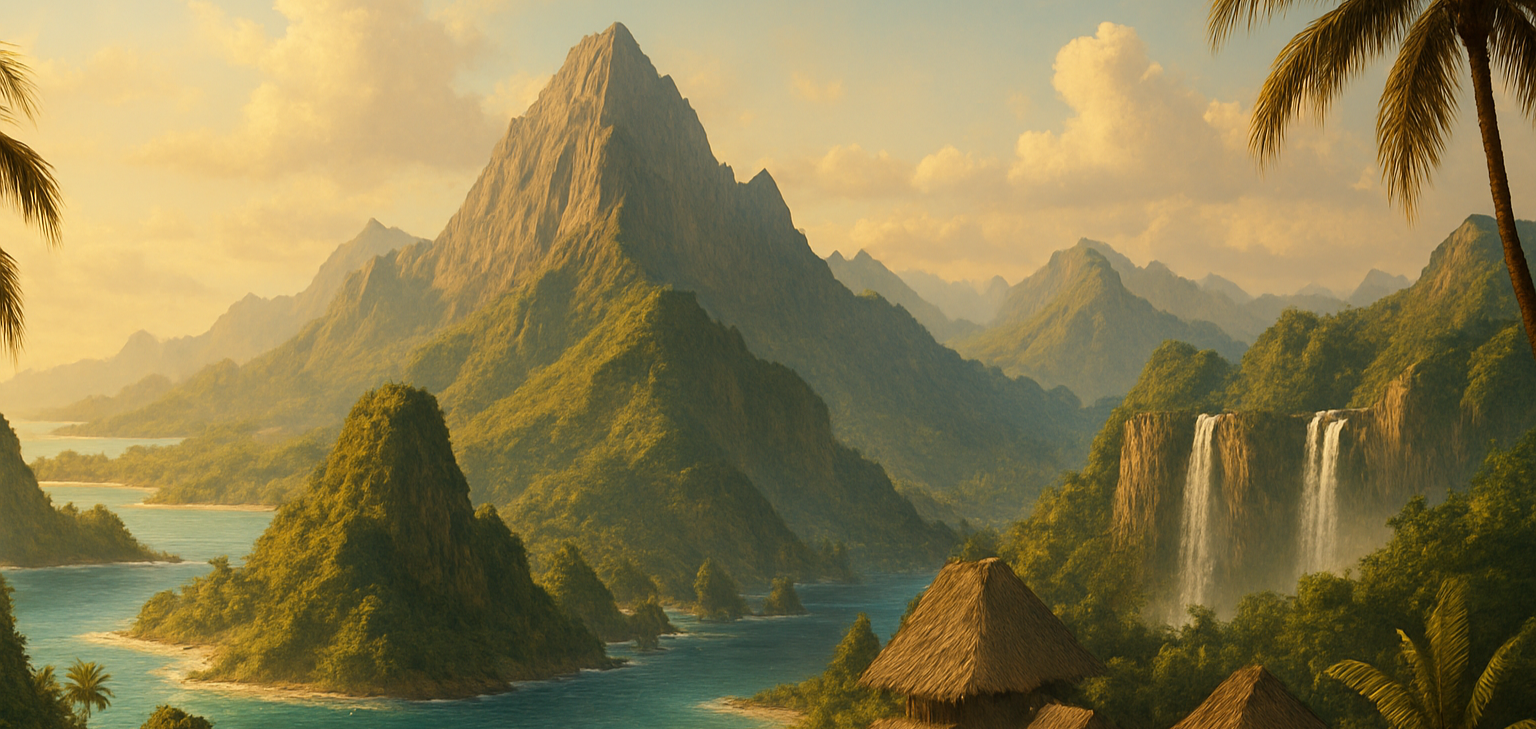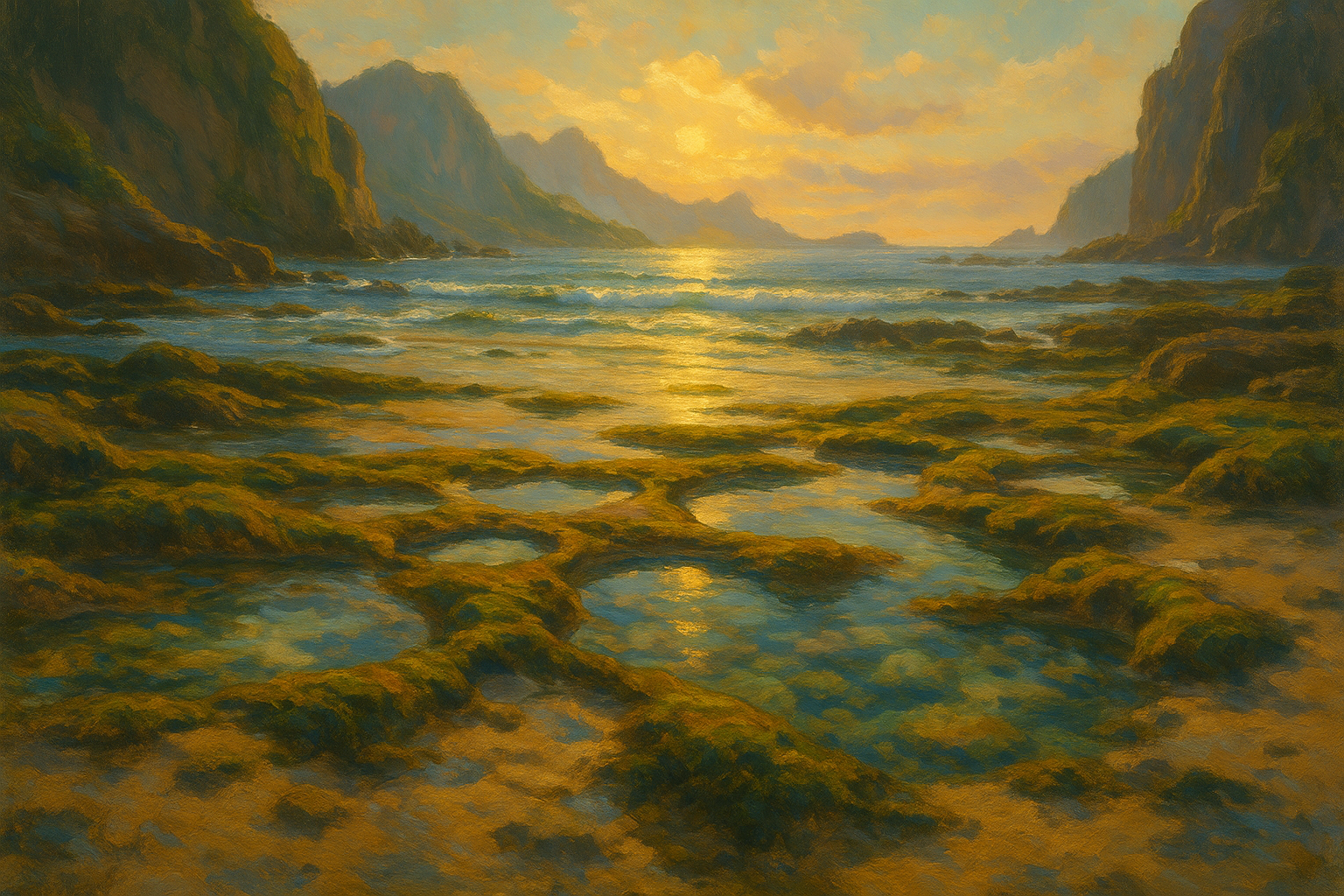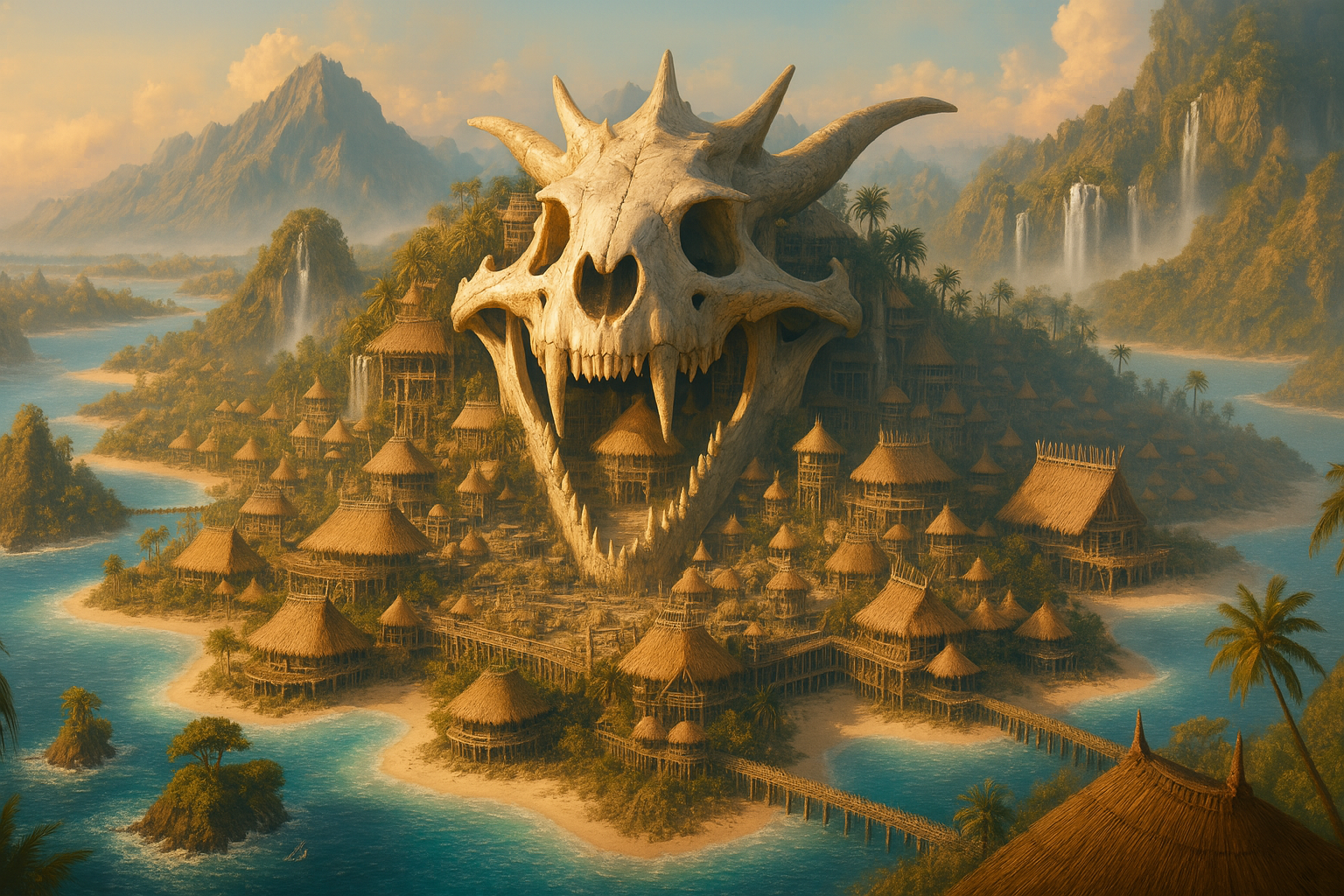Ulanakea (oo-lah-nah-KAY-ah)
Nestled on the sun-kissed coast of Makaroa’s largest island, Ulanakea is a breathtaking city built within the colossal, weathered skeleton of a long-dead dragon. The creature’s massive skull crowns the hillside like a guardian spirit, its fanged maw forming the ceremonial heart of the city. Radiating outward along the shoreline and into the cliffs are stilted wooden structures with thatched roofs, linked by graceful walkways that hover above white sands and crystalline waters.
The people of Ulanakea believe the great beast, called Ahinakoa or “Fiery Ancestor”, was a divine messenger whose death marked the birth of their island's spiritual destiny. Its bones are sacred, adorned with carvings and offerings. The skull itself houses a central temple where rites of passage, ancestor worship, and fire festivals are held. During solstice, the rising sun aligns perfectly with its eyes, casting light deep into the ceremonial chamber behind its jaws.
Though peaceful in appearance, Ulanakea thrives with life, fisherfolk, storytellers, bone-crafters, and tide-callers make their homes here. Pilgrims, scholars, and daring travelers journey from across Tanaria to walk beneath the dragon’s ribs and witness the city’s legendary harmony of reverence, artistry, and natural splendor.
Demographics
Ethnic Composition:
- Primarily Makaroan (islander peoples deeply connected to land, sea, and spirit).
- A smaller population of mixed ancestry (half-elves, water genasi, and sea-touched individuals) often serve as tide-callers, fishers, and spirit mediums.
- Small enclaves of Tanarian mainlanders—merchants, researchers, and mystics—reside in the outer wharfs or university enclaves.
- A few dragonborn and kobolds live in the city as bonewrights or relic keepers, drawn to the spiritual significance of their ancestral connection.
Religious Belief:
- Predominantly Sylvanna (nature and growth), Umbra (knowledge and consequence), and localized ancestor worship of fallen heroes and the dragon itself, now considered a semi-divine being or spirit guardian.
- A few sects worship Thalassara, Goddess of the Ocean, particularly among coastal fisher clans.
Social Structure:
- Loosely matrilineal clan system tied to specific bones of the dragon—e.g., families who live beneath the left ribs have different ancestral chants and rights than those near the skull or spine.
- Elders and spiritual leaders (shamans, dream-seers, tide-priests) hold the most power, with elected stewards serving as civil governors.
Government
Sacral Councilship with Communal Stewardship
Ulanakea is not ruled by a monarch or conventional government but by a Council of the Bones—a spiritual-political body composed of clan elders, shamans, and tide-priests, each representing a different region of the city, traditionally tied to a part of the dragon’s skeleton (e.g., the Skull Seat, the Left Rib Circle, the Spinehold, the Clawward). This council governs by consensus, guided by prophecy, ancestral wisdom, and communal wellbeing. The balance of power leans heavily toward spiritual leadership, with the Dream-Seer—a chosen shaman who sleeps beneath the dragon’s skull during solstice rites—serving as the city’s highest voice in matters of omen, vision, and divine will. Day-to-day governance and external diplomacy are handled by a Steward of Ulanakea, elected from among the council for five-year terms. The Steward acts as a coordinator and mouthpiece but does not rule independently. All major decisions, especially those concerning the dragon’s remains, must be confirmed by the Council.Council of the Bones:
- Comprised of 9–13 members, each representing a clan district, sacred bone region, or societal pillar (e.g., fishers, carvers, spirit-callers, tideborn).
- Council positions are hereditary but can be challenged through ritual debate or ceremonial trial, emphasizing both legacy and merit.
- Council gatherings are held in the Heartspire, a chamber carved within the dragon’s sternum.
Legal System:
Justice is restorative and communal. Offenses are judged by circle tribunals, where both the offender and harmed parties must participate in resolution under the guidance of a neutral Bonekeeper (a kind of spiritual mediator). Severe crimes—such as defiling dragonbone or harming the Dream-Seer—are judged by the full council and considered spiritual violations punishable by exile, not death.Industry & Trade
Despite its spiritual origins, Ulanakea is a thriving and self-sustaining coastal city. Its people, known as Ulanakeans or Nā Kea, live in close harmony with the land and sea, drawing their livelihoods from ancestral knowledge and ritualized craft. The surrounding reefs and warm waters provide ample fish and shellfish, while the terraced jungle gardens nestled against the cliffs yield taro, yams, medicinal herbs, and ceremonial flowers. These gardens are cultivated communally, and each clan tends specific plots tied to their ancestral lineage.
One of Ulanakea’s most unique trades is bonecrafting. Skilled artisans, known as bonewrights, create sacred tools, talismans, and ceremonial instruments carved from sanctified fragments of the dragon’s remains. These artifacts are heavily regulated by the Council of the Bones, no one may sell, export, or even shape dragonbone without spiritual permission. Alongside these are carvings made from spiritwood, driftwood believed to carry ancestral memory, and dyed tattoos or fabrics imbued with meaning, using pigments like the rare Ahi Kula Ink, a vibrant red made from fermented squid dye and volcanic flowers.
While most residents live simple lives, many serve as ritualists, spirit-guides, or dream interpreters. These roles are deeply honored in Ulanakean society. Though not paid in the conventional sense, those who offer spiritual insight or lead public rites are gifted food, tools, or ceremonial items in gratitude. This barter- and offering-based economy ensures that even those who live for spirit and dream are supported by the community.
Ulanakea exports only what aligns with its values. Its most prized exports, spiritwood carvings, bone charms, Ahi Kula Ink, and fermented coral mead, are rare, handcrafted, and spiritually significant. These goods fetch high prices across Tanaria, especially among scholars, nobles, and magical orders. However, their export is strictly limited to preserve cultural balance. In return, Ulanakea imports essential resources that it cannot produce locally: forged metals, arcane reagents, glass, and fine textiles. The people prefer to work with stone, bone, and wood, so iron and bronze tools are especially valued and carefully rationed.
Ulanakea’s economy is not driven by conquest or commerce, but by purpose and identity. Its people trade, fish, and craft not to amass wealth, but to preserve balance, honor the fallen, and ensure the city remains what it has always been: a sacred refuge built on death, memory, and rebirth.
Points of interest
Ulanakea boasts a number of striking and mystical points of interest, each woven into the city's identity and spiritual fabric. Tourists and pilgrims alike flock to these landmarks, not just for their beauty, but for the reverence they command.
The Skull Gate is the most iconic feature—formed from the massive, horned skull of the fallen dragon. It looms above the central district, its yawning mouth serving as both a ceremonial entrance and a place of offerings. During high holy days, it glows faintly with residual divine energy, and it’s said that those who pass through it during a full moon will dream of their ancestors.
The Spinewalk is a narrow, suspended path that runs along the dragon’s vertebrae, stretching across a cliffside and providing panoramic views of the ocean and the surrounding jungle canopy. Each vertebra has been carved with symbols of protection and memory, and locals often leave flowers, shells, or woven charms as tributes.
The Ribcage Sanctum is perhaps the most spiritually charged location in Ulanakea. The enormous bones arc overhead like cathedral arches, housing ritual grounds, meditation spaces, and spirit pools. Light filters through the gaps in the ribs at dawn and dusk, creating breathtaking plays of color across the sand and stone. It’s here that many important rites are held, from seasonal ceremonies to the quiet vigil kept by the Dream-Seer.
The Tide Pools of Keleko—natural formations near the southern beach—are believed to be infused with the essence of the dragon’s fall. Some bubbles shimmer with soft magic, and soaking in them is said to grant clarity, fertility, or prophetic visions. Locals treat the pools with great care and only permit access under certain conditions.
The Whispering Hollow, deep within the cliffs behind the city, is a cave where the dragon's heart was said to have come to rest. Visitors report hearing strange voices or feelings of being watched. It's become a place of pilgrimage for those hoping to receive a message from the beyond—or to test their bravery.
Ulanakea is not only beautiful and awe-inspiring; it’s alive with myth, memory, and sacred energy. The land itself feels ancient and watchful, and visitors are reminded constantly that they walk among bones, not ruins.
Tourism
Tourists who journey to Ulanakea are not typical thrill-seekers or beachgoers, they're pilgrims, scholars, mystics, and adventurers drawn by the mythic aura of the island. Many come seeking a brush with the divine or to immerse themselves in the city’s ancient, sacred atmosphere. For some, it’s a religious experience: a chance to walk beneath the ribs of a fallen god-beast, to hear whispered wisdom in the Dreaming Chambers, or to offer prayers within the ribcage during a tide-lit vigil. For others, it’s about curiosity, arcanists and historians fascinated by the structure of the dragon’s bones, the spiritual rites performed around them, and the lingering magic that saturates the island.
Artists and bards are also common visitors, inspired by the breathtaking scenery and the reverence that pulses through daily life in Ulanakea. They sketch the view from the Spinewalk or try to capture the sunrise glowing through the dragon’s eye sockets. Couples sometimes visit hoping to be wed beneath the jawbone, a sacred space believed to seal unions with lasting spiritual harmony.
During their stay, visitors are housed in designated Guest Lodges outside the central sacred zone. These structures, built in traditional Makaroan style from spiritwood and woven palm, are simple but beautiful, elevated over the sea and lit with lanterns shaped like sea creatures or bones. Each lodge is maintained by a hosting clan, who provide food, spiritual orientation, and access to guided rituals. Wealthier guests may secure spots in Skybone Pavilions, perched higher in the cliffs with views of the dragon’s spine, but even these remain modest and respectful of the city’s traditions.
Tourists are forbidden from entering sacred council spaces or handling relics, and all must participate in the Welcome Rite, which involves a cleansing dip in a tidepool followed by offering a carved token to the spirits of the island. It's not just a tradition, it’s how one earns the right to walk the paths of Ulanakea without drawing ill omen.
Ultimately, what tourists seek is not entertainment but meaning, a glimpse of the divine, a connection to the ancient, and the chance to say they stood in the bones of a myth.
Founding Date
40–70 HE
Alternative Name(s)
Ka’iwalu" (lit. “Sacred Ribcage”), The City of Bones,
Type
City
Population
Estimated 23,000–26,000 permanent residents
Inhabitant Demonym
Ulanakean
Nā Kea (nah KAY-ah) — “The Kea” or “People of the Bones” This is what locals call themselves
Nā Kea (nah KAY-ah) — “The Kea” or “People of the Bones” This is what locals call themselves
Location under
Owning Organization







From the initial view on the horizon, the great skull of the dragon I'm sure being one of the first things you see, to the peoples, culture and points of interest, this is most certainly a place I would wish to visit and immerse myself in. So much to learn, to see, and such a unique vista and locale. Well written, a wonderful destination article, you're on fire this camp!! A most worthy locale I simply must add to my collection. :)
Thank you so much for the kind words! This was a hard one for sure, sometimes its hard to not go too deep, ya know?
"Every story is a thread, and together we weave worlds."
The Origin of Tanaria